Article updated on March 12, 2025
Texas Hold’em is not the only poker game on the block. Nowadays, players can choose to play many types of poker games.
In this article, we’ll explain a little bit about the many forms of poker, how to play poker, basic strategy basic strategy, and their current popularity.
Follow along as we take you on a journey into several different types of poker!
Texas Hold’em
Texas Hold’em is currently the most popular variant among all the modern poker types. If you can find a card room or website that offers poker games, Texas Hold’em will almost surely be the featured game with a wide selection of tables and stakes for players. Most players may recognise this format from televised games like the World Series of Poker and the WPT Poker Tour.
Many players, amateur or pro, exposed to poker since the early 2000’s will likely know the game of No-Limit Texas Holdem the best. It’s been the most heavily televised and popularised poker variant since the turn of the millennium and has easy-to-pick-up hand rankings and rules.
Knowing the poker hand rankings is critical and consulting a poker cheat sheet is beneficial when you start learning the game. Playing online is also an excellent option for learning the game and working on your strategy.
Popularity: 10/10:
In 2003, Chris Moneymaker turned a $86 satellite entry into a $10,000 WSOP Main Event win for $2.5 million, making every onlooker yearn to experience the same fame, money, and glory as this amateur. The establishment of online poker around the same time led to the biggest “poker boom” to date.
Many inspired players could easily learn the game of poker and play it from the convenience of their own homes via the Internet. Years later, this boom helped establish and solidify NLHE as the Cadillac of Poker - the most popular among the types of poker.
Ease of Learning: 8/10:
Hold’em is an easy game to learn and improve at. Its sheer popularity has created many informational sources (videos, books, articles) that give strategic insights into the game.
Gameplay:
Firstly, the two players to the left of the button place forced bets called “blinds”. After the dealer deals two hole cards to each player, the action starts with the player to the left of the big blind and continues clockwise. Players may either call, raise, or fold.
- After this first betting round, three cards are dealt onto the table (called the “flop”). These “community cards” are for all players to use simultaneously to make the best poker hand.
- After another betting round, one more community card is dealt (the “turn”), followed by another betting round and then the final “river” community card.
- After one more round of betting, any remaining players in the hand must show their cards.
The player who has the best five-card poker hand made up of any combination of their two hole cards and five community cards wins.

There are some slight differences between Hold’em tournaments and cash games:
- In cash games, players bet with actual money equal to their buy-in chips and can leave the table at any time, whether they win or lose.
- In tournaments, the poker chip values are based on the tournament structure, and blinds increase throughout the tournament
Texas Hold’em Pros:
Because of its popularity, you can usually find this game anywhere that offers different types of poker.
Texas Hold’em Cons:
The popularity of Hold’em is a double-edged sword. Because the poker boom happened 15-plus years ago, the number of informational products and articles available now has sped up the learning of the game. This factor has helped to level the playing field and skill gap between pros and recreational players.
Omaha-Hi
Second in popularity among the most popular poker types is Omaha-Hi. In this game, the “Hi” refers to the highest hand being awarded the entirety of the pot at showdown. Omaha-Hi is usually played as a pot-limit game, which is more commonly referred to as Pot-Limit Omaha (or PLO).
In a nutshell, this game plays exactly like Texas Hold’em, but with one small difference: each player receives four hole cards instead of two. Players still try to make the best five-card hand but must use two of their four hole cards and only three of the five community cards at showdown.
Because players get more cards at the start of each hand, making a good hand is much easier, as the number of two-hole card combinations increases by 6!
Popularity: 8/10:
Not all casinos and card rooms will have PLO tables and games available as Texas Hold’em. However, many will offer it as one of their secondary poker types, albeit with far fewer tables.
Ease of Learning: 8/10:
If you know Texas Hold’em, this game is straightforward to learn, as the two have many similarities. Strategically speaking, it is much easier to make a good hand in PLO, so typically, hands at showdown are higher than those in Texas Hold’em.
Blockers (cards that you have in your hand) mean that your opponent cannot hold those same cards) are much more relevant in PLO. Additionally, the poker bluff in PLO is almost impossible to execute.
Gameplay:
Action proceeds just like a hand of Texas Hold’em, with two distinct differences:
- Players receive four hole cards instead of tw
- The sizes of bets and raises are usually capped at the pot size (if Pot-Limit Omaha is the variant).
Omaha-Hi Pros:
The increased number of hole cards will make it easier to form a strong hand.
Omaha-Hi Cons:
The variance is quite high in Omaha-Hi because equities between hands will often run much closer than in Texas Hold’em. Players can use different combinations of their hole cards to improve the strength of their hand.
Go here for an in-depth guide to Omaha-Hi games.
Omaha-Hi-Lo
Omaha-Hi-Lo (also known as Omaha 8 or Better) is a variant similar to Omaha-Hi, except that the pot at showdown is divided equally in two between the highest-ranked five-card poker hand and the lowest.
Different combinations of hole cards can make both the high and low hands. However, specific conditions must be met to win the “low” half of the pot.
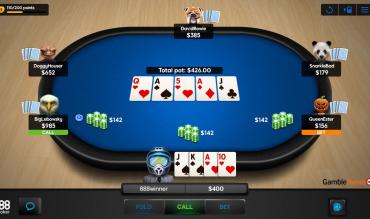
This area is where the “8 or better” part of the name comes into play - all five cards making up the “low” hand must be ranked eight or lower. Additionally, straights and flushes do not count against a hand in this variant.
The lowest possible hand would be any A-2-3-4-5 poker combo, while the highest “low” qualifying hand would be 8-7-6-5-4. Note that the lowest hands are ranked from the highest card downwards (i.e. 6-5-4-3-2 would be better than 8-4-3-2-A for the low).
Many players enjoy Omaha-Hi-Lo not just because of the split-pot element but also because players go for the high and low to scoop the win.
Popularity: 4/10:
While undoubtedly nowhere near as popular as Omaha-Hi, this poker variant can still be found in select online poker rooms and large tournament series and events.
Ease of Learning: 4/10:
Because players must think of both high and low combinations of hands in this poker variant, things are slightly more complex than making the best, highest-ranked hand. Additionally, having to know the specifications and rankings of a qualifying “low” hand makes this variant more complicated than its Omaha-Hi counterpart.
Gameplay:
Gameplay proceeds like in Texas Hold’em and Omaha-Hi, with five community cards and multiple betting rounds - before the flop, after the flop, after the turn, and after the river.
The pot is divided equally between the highest and lowest hands at showdown. If there is no qualifying low hand, the highest hand scoops.
Omaha Hi-Lo Pros:
With the pot split in two between the highest and lowest hands, it’s subsequently easier to win (a portion of) the pot in any given hand.
Omaha Hi-Lo Cons:
Bluffing is a less prominent part of the game than in other types of poker because players might be trying to make the highest hand OR the lowest hand (or both). As such, more players will stick around until showdown.
Therefore, more emphasis is placed on hand selection (making both low and high card hands simultaneously) than on making well-timed bluffs.
Learn more about how to play Omaha-Hi-Lo here.
7-Card Stud
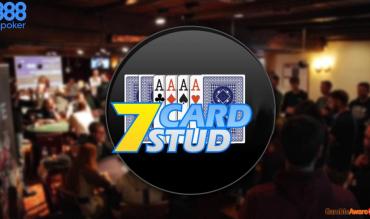
Before the surging emergence of Texas Hold’em to the forefront of poker’s popularity, Stud poker used to hold ground as the most common form of poker.
Aside from the different types of poker, which use hole cards and community, each player in Stud ultimately receives their own individual hand. Some cards in one’s hand will be face-down, while others will be face-up for the rest of the opponents to see.
Popularity: 4/10:
Stud is no longer the number one game among various types of poker. Nowadays, it is primarily played in particular tournaments, either those featuring only Stud or mixed games.
Ease of Learning: 6/10:
Because the game revolves around creating the best five-card poker hand, this is undoubtedly one of the easier poker games to learn. Strategically, however, it’s challenging to master because each player has their own separate hand with only some of their cards exposed.
Understanding how to read your opponent’s potential hand strength and compare it to your own is an essential skill for winning this game.
Gameplay:
All players dealt into a hand must also put forward an ante. After this, each player receives two face-down cards and one face-up.
- The player with the lowest face-up card acts first and must either make a small “bring-in” bet or a complete bet of the smaller increment of the game. Betting continues in a clockwise direction.
- After the betting round concludes, the remaining players get another face-up Now, the player with the highest value of exposed cards is first to act and must make a bet of the smaller increment if they choose to bet.
- Fifth Street and Sixth Street (and their corresponding betting rounds) both ensue afterwards, with one additional face-up card per street.
The player with the highest combined value of exposed cards acts first after both streets and in both these betting rounds, the larger of the betting increments is active.
On Seventh Street, each player receives one final card face down, at which point they must make the best five-card hand with the seven cards they’ve been dealt.
After the final betting round, Showdown is reached, and the player with the best hand wins.
- Paying attention to other players’ hands is critical in Stud poker (there is also an older five-card version of the game that was popular in the Old West but not seen much today).
- Gauge your opponents’ hand strength by observing their upcards and what hands they might have or be drawing to.
- Remembering what key cards have been folded can also determine the possible strength of your own and others' hands.
7-Card Stud Pros:
It's fun to create your own individual poker hand while still being able to see four of your opponents' seven cards during a hand.
7-Card Stud Cons:
With a limit betting structure typically used for stud, profits are usually capped. The value of gaining an additional big bet (versus losing one) carries much more significance than otherwise.
Discover all you need to know about 7-Card Stud games.
2-7 Triple Draw
This exciting form of poker has all players receiving their own individual five-card hand (which no other players can see in any capacity). In this low-ball form of poker, players have not one but three draw attempts to make the best “low” hand.
Unlike some other “low” forms of poker, it’s essential to note that straights and flushes do count against making a low hand. Additionally, note that Aces are always high in this game. As such, this makes the best hand possible in this game 7-5-4-3-2. It also means that a hand like A-2-3-4-5 isn’t a straight but Ace-high.
Popularity: 4/10:
It’s not uncommon to see this poker variant played at nosebleed stakes where the best poker players of all time get down, although its popularity has waned in recent years. Typically, 2-7 Triple Draw is a form of poker most frequently found in mixed games.
Ease of Learning: 7/10:
This form of poker is relatively easy to learn and understand. The gameplay is simple and easy to follow. In essence, you need to know what straights and flushes are – so you don't mistake having them in your low hand. However, it's straightforward to understand what makes the lowest, unpaired five-card hand means.
Gameplay:
Triple Draw has small and big blinds, which are forced bets that the players to the left of the dealer button must post before any cards are dealt.
Then, after dealing five cards to each player, an initial round of betting takes place. Players can discard anywhere from none to all their cards. Not drawing any cards is called "standing pat".
In total, three draws occur during each hand. After each draw round, there is a round of betting, which always starts with the first player still in the hand seated to the button's left.
2-7 Triple Draw Pros:
You have three draw chances (instead of just one) to make the lowest-ranked hand. Additionally, it’s very easy to determine the strength of your hand, as you only have five cards (as opposed to seven or more in other forms of poker).
2-7 Triple Draw Cons:
None of your opponents’ cards are visible. So, you have nothing when trying to deduce the strength of your opponents’ lowball hands. Additionally, some players may not find this poker variant as fun as other poker types because you’re trying to make the lowest five-card ranked hand (instead of the highest).
Find out all the rules behind the game of 2-7 Triple Draw.
5-Card Draw
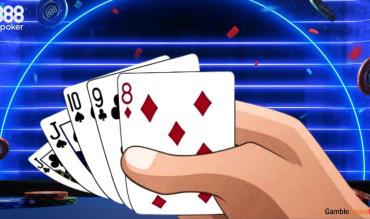
Players look to make the highest-ranked five-card poker hand in this form of draw poker. Draw poker differs from other types of poker, like Hold’em and Omaha, because players can discard cards and receive (draw) others.
To begin with, all players receive a separate hand, which remains hidden from their opponents. This factor makes for an interesting dynamic. As you try to make a strong hand, you have no idea how it’ll fare against other players' hands.
Popularity: 5/10:
In a variety of poker movies featuring a friendly game of poker, it’s not at all uncommon to see 5-card draw poker being the poker type of choice. Onlookers can easily assess the strength of each player’s holdings almost instantly because each player’s five-card hand is face-up.
- However, some players may bluff by taking fewer cards than they need.
- Some players with strong two-card hands may also draw the remaining cards.
Having a good read on opponents can help in this game.
Ease of Learning: 9/10:
This game is straightforward to learn, as there's only one drawing round, two betting, and five cards for each player. (These will be the same five cards used to make their best possible poker hand). Besides the need to learn the standard poker hand rankings, 5-Card Draw is straightforward to play.
Gameplay:
Like Hold'em, the action starts with a small blind and big blind being put forward before any cards are dealt. After this, each player receives five cards. The betting action starts with the player seated to the left of the big blind.
During this pre-draw betting round, players may fold, call, or raise. The remaining players then have the opportunity to draw between 0 and 5 cards.
After this draw, there is one more round of betting before Showdown for any remaining players, where the player with the best hand scoops the pot. Some home games may use an ante structure instead of the blind structure.
5-Card Draw Pros:
With only one drawing round, the game is easy to follow and understand and quick to move from one hand to the next. You'll play many more hands per hour in this game than you would in some different types of poker.
Additionally, that "one shot" of drawing a new card to see if you can improve your hand adds to the fun element.
5-Card Draw Cons:
None of your opponents’ cards are visible. So, you have nothing to go by other than bet sizings and the number of cards drawn to deduce the strength of your opponents’ hands.
Learn the ins and outs of playing 5-Card Draw.
5-Card Omaha
If you like the thrill of being able to make strong hands easily in Omaha-Hi, then be sure to check out the action that 5-card Omaha (also known as “Big O”) brings to the felt! Instead of being dealt four hole cards, each player receives five to begin each hand.
Still, players must use exactly two of their hole cards and three of the community cards to make the best hand. But, with one more hole card than in regular Omaha, there are now even more possibilities for making stronger hands than in many other types of poker!
This game is typically played in a pot-limit format but might also occasionally be played as a no-limit game.
Popularity: 6/10:
While not as popular as normal Omaha-Hi, 5-card Omaha still attracts many action junkies in poker. Played primarily online but also now seen more in live tournament and cash game settings, the money is undoubtedly guaranteed to be flying back and forth in these games.
Ease of Learning: 8/10:
This variant has the same rating as learning traditional Omaha-Hi; the only difference is the extra hole card. To play it, you'll need to know the rankings of various poker hands as in other types of poker games. However, to play it well, you must have excellent starting hand selection skills, solid post-flop gameplay strategies and a resilient and tough mental attitude to handle the massive swings.
Gameplay:
|
The gameplay is like regular Hold'em or Omaha-Hi games. Small and big blinds are put forward, and everyone receives five hidden hole cards. After an initial betting round that starts with the player seated to the left of the big blind, the flop, turn, and river are dealt (three cards, one card, and one card, respectively) with a separate round of betting after each street. Any players still in the hand after the river betting round go to "showdown," where they turn their cards face up. The pot is awarded to the best five-card hand (consisting exactly of two hole cards and three community cards from the poker board). |
5-Card Omaha Pros:
If you like making big, strong hands, this game is for you! With an additional hole card in the mix for each player (vs regular Omaha), be prepared for loads of action at the table!
5-Card Omaha Cons:
The swings are much more significant because of Omaha's naturally more aggressive nature (with more frequent higher made hands). So, you must have a bigger bankroll and a strong mental attitude to survive the knee-buckling variance.
Now that you’ve discovered 5-Card Omaha learn how to really play it.
Badugi
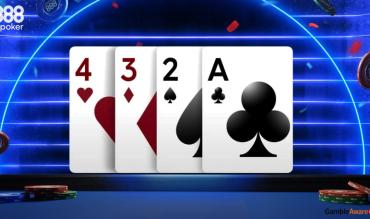
This poker variant falls under the “draw” and “Lowball” poker families. However, Badugi is unique compared to other different types of poker because of its peculiar hand ranking system. Being adept in another form of poker doesn't necessarily cross over to Badugi.
Popularity: 3/10:
Originating in the 1980s, Badugi is a relatively newer form of poker. Since its introduction, it has never gained the same notoriety as the more popular games. However, it is still played in select online poker rooms and home games. If it's found in a large tournament series, it's usually part of a "mixed" event.
Ease of Learning: 3/10:
Because Badugi's hand ranking system is unlike other lowball poker games, it does take a bit of getting used to. Firstly, unlike the traditional five, four cards are used for the hand rankings. Additionally, suits do matter in this game! (If possible, you want to have all four cards in different suits.)
It’s also essential to note that straights do not count against the low hand, and Aces always play as a low card! The objective is to try to make the lowest possible “Badugi” (by definition, four unpaired cards in different suits).
Hands rank from the highest card downward (i.e. 6h-5s-4c-2d would beat 7h-3s-2c-Ad). If players have the same high card, then the second card is used to determine the lowest hand (and so on). If players have a pair in their hand or multiple cards in the same suit, then only one of the cards of the pair would be used and/or the highest card(s) of the same suit would be discounted.
This rule, in turn, would make a hand like A-A-A-2 essentially a “two-card hand” as per the ranking system (A-2) and a hand like As-2s-3s-4s a “one-card hand” (As).
Any three-card hand would lose to any Badugi, but it would beat any two- or one-card hands, in addition to some three-card hands.
In this game, the best possible hand would be A-2-3-4 in different suits, making the worst hand K-K-K-K.
Gameplay:
|
The players seated to the left of the button put forward small and big blinds. After everyone receives four cards, the player to the left of the big blind starts the first betting round with either a call, raise, or fold. The remaining players proceed through three rounds of “draws”, with a betting round after each. They may choose to discard anywhere between zero and four cards when drawing. If any players remain in the hand after the final betting round, a showdown is reached, and the player with the lowest hand wins. |
Badugi Pros:
Gameplay for each hand occurs just as it does in 2-7 Triple Draw (Lowball), so if you’re familiar with this poker variant, you’ll understand how things will work in Badugi.
Badugi Cons:
Because Badugi's hand ranking system is unique and dissimilar to other popular forms of poker, it will undoubtedly take a bit of time to adjust. Additionally, with this being a form of draw poker, you have no added information on the strength of your opponents' hands. Therefore, you’re likely to be in the dark as to how your hand fares relative to theirs before reaching Showdown.
Get to know all the little nuances in playing Badugi.
HORSE

Instead of being a separate variant of poker, HORSE is an acronym that includes five different poker variants:
- Hold’em
- Omaha Hi/Lo
- Razz (Stud Lo)
- Stud (Stud Hi)
- Eight-or-Better (Stud Hi/Lo)
HORSE will most often appear in high-stakes live games and select, prominent tournament series, like the World Series of Poker (WSOP).
Popularity: 5/10:
Mixed games like HORSE are often played in live settings in higher-stakes games, in an attempt to level out the playing field. The premise is not to allow single-game specialists to run over the table as they might otherwise.
HORSE also serves as an ultimate test of true poker ability by combining multiple variants (which require different skills) into one poker game.
Ease of Learning: 2/10:
HORSE combines five poker variants (across three primary game types: Hold 'em, Omaha, and Stud). Therefore, learning and becoming good at all five will be more complicated for any individual variant.
Gameplay:
| Each game variant follows its standard gameplay rules. Specific to HORSE, all games are fixed limit, with the same stake/structure across each variant. The games are played in order (i.e. Hold’em first, then Omaha, then Razz, etc.) and flip to the next game after each orbit. |
HORSE Pros:
Playing a mixed game like HORSE eliminates the monotony and routine of playing one game type repeatedly. Therefore, it can create a more enjoyable poker experience, allowing players to play and try different forms of the game, all in one sitting.
HORSE Cons:
HORSE would be bad for single-game specialists because it levels out the playing field by including the other games. Additionally, to stay afloat, one would have to learn and develop skills across a variety of poker games.
Find out how to play HORSE games the right way.
Razz

Razz is a form of Stud Poker in which players try to make the lowest hand possible. In the ranking system for this game, straights and flushes do not count against a low hand. Additionally, Aces count as low in this game, meaning the lowest/best hand possible would be A-2-3-4-5.
Popularity: 3/10:
Razz is occasionally played as a dedicated game type, but is most frequently included in mixed games, such as HORSE.
Ease of Learning: 7/10:
It’s very easy to identify the lowest possible 5-card hand from the seven cards that a player has available. (Players simply look for the lowest, unpaired cards in their hand). Therefore, Razz is relatively easy to play.
Gameplay:
|
The gameplay in Razz proceeds very similarly to normal Stud Poker: all players start by putting forward an ante. After this, everyone receives two face-down cards, and one card dealt face-up. Opposite to Stud types of poker games, the player with the highest face-up card in Razz acts first, making either a small “bring-in” bet or a complete bet. After this, the betting round continues in a clockwise direction. The remaining players are then dealt another face-up card. The player with the lowest (strongest) combination of exposed cards is first to act and can check or make bet the smaller increment used in the game. After this betting round concludes, Fifth Street and Sixth Street ensue, with one additional face-up card dealt per street. The player with the lowest/best exposed cards acts first in these betting rounds. Additionally, the betting increment during these later streets is the larger one in the game. Each player receives one last card face-down for the seventh and ultimate street, at which point they can determine their lowest five-card hand. After a final betting round, Showdown is reached, and the player with the lowest hand wins. |
Razz Pros:
With Razz being a limit structure game, bets and raises are more streamlined, making it easier to know what action to take. Bet-sizing won’t be a consideration. Also, unlike other lowball games (like Draw), it’s nice to see some of your opponent’s cards to compare your low hand.
Real strategy considerations exist in Razz as in Seven Card Stud. Look at other players' upcards to get an idea of where they stand and also try to remember folded cards.
Razz Cons:
If you enjoy trying to make the highest hand possible, then Razz's "lowball" aspect will be a con for you. Additionally, it can be more challenging in Razz to determine what your ultimate "low" hand will be until the later streets. In a "high hand" game, you only need two cards to make a pair, which can then still further improve.
In a “lowball” game, you’ll need to see at least five cards that are low and/or ideally unpaired before knowing how to proceed.).As such, it’s easy to be curious and want to get to Seventh Street more often than you should, which will likely create a dent in your poker profits.
Learn all you’ll ever need to know to play Razz poker games.
Chinese Poker
Chinese poker differs significantly from other poker variants, as it doesn’t follow any more traditional game patterns. That said, it is still a beginner-friendly game, and the biggest prerequisite is having a good knowledge of poker hand rankings.
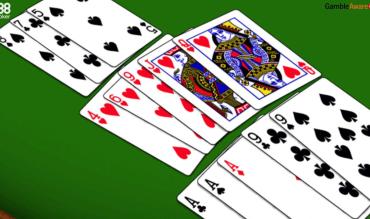
Popularity: 3/10:
Chinese poker isn’t the most popular form of poker, but it is still active. Its peak was arguably during the mid-1990s, when there were WSOP events in 1995 and 1996. However, since then, there have been no Chinese Poker events at the WSOP.
Ease of Learning: 4/10:
Chinese Poker is quite an easy game to play. But it can get more complicated to understand the different scoring systems and to decide whether to use “royalties” (bonus points)—and if so, which ones.
The most significant prerequisite is understanding the standard hand-ranking system in poker. Beyond this, the more you get exposed to the scoring system, the more adept you’ll become at using it and tallying up the points.
Gameplay:
Chinese poker is usually played with four players total, but it can also accommodate between two or three players. Each player receives thirteen cards and must then divvy up their cards into three hands of various strengths:
- Their best five-card hand
- A middle-strength hand of five cards
- Their weakest hand that consists of three cards.
After this, players ultimately show their high, middle, and weakest hands in order. The player who wins each “hand” (with the highest hand for each category relative to their opponent(s)) collects one “unit” of wagering from each losing opponent.
Therefore, instead of a winner-take-all format like most other poker games, you can still win a little in each hand, even if you’re not the big winner – e.g. you win one of the three “hands”!)
In addition to this basic scoring, normally there are additional bonuses if you win two of the three hands or even all three!
If all your hands are straights or flushes, you win the entire round of hands outright! However, you must declare this to other players before “showing down” your three hands.
Chinese Poker Pros:
As the format allows for a good possibility of unlikely outcomes, luck often plays a big role in the results of this game in the short-term. This factor is great for beginners, as it allows them to have a good chance of winning.
Chinese Poker Cons:
Even if you get good at how you distribute your cards between your three hands, it can be challenging to develop a significant long-term edge over your opponents because of the amount of luck involved.
Discover the ins and outs of playing Chinese Poker games.
Short Deck
Short deck rivals strip poker as an enjoyable variant of Hold’em. It’s become a staple in high-stakes cash games and tournament series in recent years. Hand rankings in this poker game are slightly different than in traditional games (with flushes beating full houses), and for good reason: 2’s through 5’s have been removed from the deck! Therefore, the game is played with 36 playing cards (hence the name).
Texas Hold’em versus Short Deck
| Topic | Texas Hold’em | Short Deck (Six Plus) |
|---|---|---|
| Cards in Deck | 52 | 36 |
| Missing Cards | None | 2s, 3s, 4s, 5s |
| Top pair hand values | Top pair can be strong | Top pair can be weak because of so many draws |
| Pocket pairs | Highly valued especially Aces, Kings, Queens, Jacks | Less valued but still highly playable especially good if hitting three of a kind |
| Ace for a straight | Used to make a straight of A-2-3-4-5 | Used to make a straight of A-6-7-8-9 |
With fewer cards, players have better chances of making some hands but must also be wary that this applies to the strength of their opponents’ hands, too! With fewer cards comes higher variance and the chances of making stronger hands more frequently.
Popularity: 7/10:
With big poker series and media coverage of the high-stakes games played in China in recent years, Short Deck has surged in popularity! While it’s still not a standard game in many card rooms or online poker rooms, it is undoubtedly an attractive and fun form of poker.
Ease of Learning: 6/10:
The game of Short Deck is relatively straightforward to learn. If you’ve played Hold’em, you’ll have an easier time picking up this game than if you’re new to poker altogether. (Just be sure to remember the different hand-ranking rules!)
Regarding learning strategy for Short Deck, it is a relatively new game in today’s poker world. So, there’s not that much that’s been written or shared on the topic regarding strategy. This fact makes learning how to play profitably slightly more complicated.
That said, if you take the time to develop your own winning strategy just as the game is emerging, being a pioneer in this variant could lead to large potential profits.
Short Deck Odds
| Topic | Texas Hold’em | Short Deck (Six Plus) |
|---|---|---|
|
Chances of being dealt any pocket pair |
5.9% | 8.6% |
|
Chance of being dealt pocket Aces |
1 out of every 221 hands (0.45%) | 1 out of every 100 hands (1%) |
| Lowest straight | A-2-3-4-5 | A-6-7-8-9 |
|
Odds to hit flush draw after flop by the river |
36% | 30% |
|
Odds to hit open-end straight draw after flop by the river |
31.45% | 45.6% |
Gameplay:
Unlikely normal Hold’em, Short Deck is typically played as an ante game. All players place forward an ante to start, which helps to build the main pot. The player on the button places forth an additional ante, which will be used for the first preflop round of betting. Action starts with the player to the left of the button, and players may either call, raise, or fold vs this button ante.
After the preflop betting round, postflop play continues like Hold’em, with a flop, turn and river (3 community cards, followed by another and then a final community card) with betting rounds after each. During these betting rounds, action starts with the first remaining player seated to the left of the button.
If multiple players remain after the final betting round, a showdown is reached, and the player with the highest hand wins the pot.
Note that Short Deck is usually played as a no-limit game, meaning players can go all-in at any point.
Short Deck Pros:
Action is thrilling in this game, as there are greater chances of making a hand or being dealt a playable starting hand (with the 2s through 5s having been removed).
An additional pro is that players can usually "go south" (take money off the table) after they've surpassed a minimum required threshold. This rule may lessen this game’s poker variance (even to a nominal degree).
Short Deck Cons:
While Short Deck is still a form of Hold’em and shares much of the same gameplay with traditional NLHE, many of the strategies in Short Deck (i.e. odds and outs, value of pairs, etc.) will be different NLHE. Additionally, equities in Short Deck will run much closer together than in regular Hold’em (because of the removed cards from the deck). This fact will create larger swings and variance for players.
Find out what’s involved in playing Short Deck poker games properly.
Pineapple
That's right – Pineapple isn't just a tropical fruit; it's also the name for a type of poker game! While this variant hasn't caught on as some of the more commonly played forms of poker, it's still undoubtedly easy to play and easy to learn. This fact is especially relevant if you know how to play regular Texas Hold'em!
Never having been in a WSOP event, this game's heyday was in some small EPT events.
Popularity: 3/10:
While Pineapple is almost identical to Hold’em with one slight twist - the number of initial hole cards! It’s never gained quite as much popularity as other forms of poker. Pineapple is more commonly played as a cash game in private home games than in casinos.
It does carry more action with it, though, than in regular Hold’em. Starting hands will be marginally better than the Cadillac of poker, with the addition of a third preflop hole card.
Ease of Learning: 7/10:
If you are already familiar with Hold'em, this rating will be more like 10 out of 10! However, adjusting strategically for the slight variation of three hole cards instead of the traditional two might throw players off a bit. It will become easier for all players to have a starting hand that they're happy with playing (or, at the very least, a better one than usual).
| Texas Hold’em | Pineapple | Crazy Pineapple | Lazy Pineapple | Super Hold’em | |
| Cards dealt | 2 | 3 | 3 | 3 | 3 |
| Cards available at showdown | 2 | 2 | 2 | 2 | 3 |
| When is one card discarded? | NA | Before betting or flop | After flop betting round | After betting on river (player can only use two cards) | Never, player can use all three cards to make hand |
Gameplay: 7/10:
If you are already familiar with Hold’em, this rating will be more like 10 out of 10! However, adjusting strategically for the slight variation of being dealt three hole cards instead of the traditional two might throw players off a bit. It will become easier for all players to have a starting hand that they’re happy with playing, (or at the very least, a better one than usual).
Pineapple Pros:
Pineapple can be more entertaining to play than Texas Hold'em because of the extra hole card at the beginning. Players are more likely to be dealt a strong/playable starting hand. This factor means you'll be more frequently involved in pots, assuming you keep the exact starting hand requirements as in Hold'em.
Pineapple Cons:
Correctly adjusting strategically for this slight alteration between Pineapple and Hold’em can be challenging. Players will get “playable” hands at a higher frequency, meaning more players will want to play.
You'll find yourself getting involved in more multi-way pots, being "outkicked" and dominated more frequently at showdown than in traditional Hold'em.


